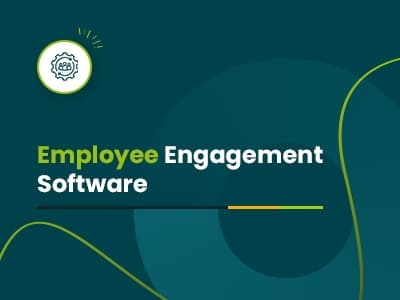Employee engagement software can make a noticeable difference in how people feel and perform at work. That matters more than ever, with Gen Z and Millennials now the largest part of the workforce, expecting more than just a paycheck. They want regular feedback, recognition, and a clear sense of purpose. The right platform makes that easier by helping your team feel seen, heard, and appreciated, which naturally leads to higher performance. In fact, Gallup research shows that companies with highly engaged employees are 18% more productive and 23% more profitable on average.
Below, we explore 9 of the best employee engagement software tools in 2025, ranging from dedicated engagement platforms to broad HR suites with robust engagement features. Let's get started!
Company | Best For | Main Features | Pricing |
Bonusly | Organizations fostering peer recognition and appreciation | Peer-to-peer recognition, points-based rewards, automated celebrations | Starts at $2/user/month |
Lattice | Mid-to-large companies aligning engagement with performance | OKRs, pulse surveys, analytics dashboards, 360° feedback | Starts at $11/user/month |
15Five | Companies wanting a feedback-first culture with check-ins | Weekly check-ins, High Fives, goal tracking, manager coaching prompts | Starts at $4/user/month |
Culture Amp | Mid-size to enterprise companies focused on engagement analytics | 40+ survey templates, heatmaps, action planning, 360° reviews | Estimated $9–$14/user/month |
WorkTango | Teams looking to merge feedback, goals, and rewards in one place | Pulse surveys, peer recognition with points, global reward catalog | Estimated $8/user/month |
Leapsome | Mid-size tech and knowledge-based companies needing a holistic solution | Engagement surveys, 360° feedback, AI-generated insights | Starts at $3/user/month |
BambooHR | Companies wanting HRIS + engagement features in one platform | eNPS, Wellbeing Heatmap, Employee Community newsfeed | $12–$22/user/month |
HiBob | Scaling mid-size global companies focusing on people and culture | DEI dashboards, kudos feed, surveys, performance tracking | $16– $25/employee/month |
Achievers | Global enterprises needing multilingual, scalable recognition | Recognition tied to company values, 25K+ rewards, Achievers Listen | Estimated $126K/year (avg contract) |
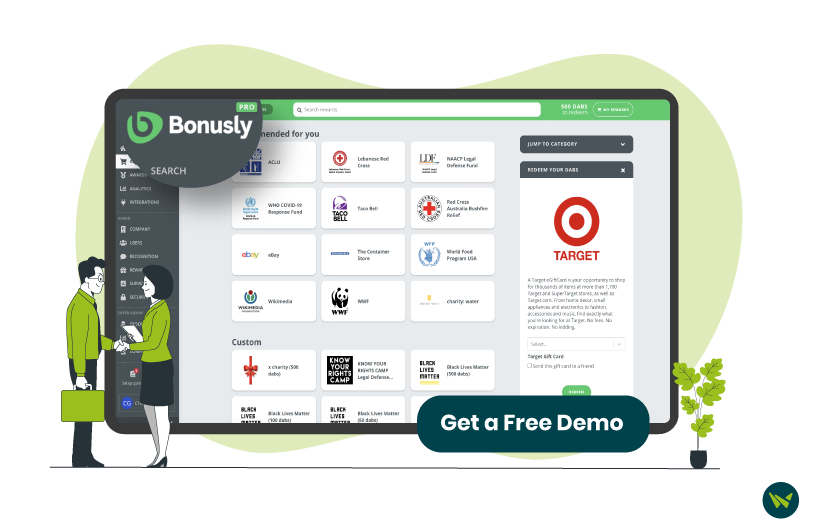
Bonusly is built to make recognition part of everyday work—not just a once-a-year thing from HR. The main feature is a peer-to-peer recognition feed where employees give each other shoutouts using points. Each message can be tied to specific company values, which helps reinforce the kind of behaviors you want to see more of.
The points aren’t symbolic—they can be exchanged through a built-in rewards catalog. That includes gift cards, donations, or custom perks chosen by your company. Bonusly also handles smaller moments automatically, like birthdays and work anniversaries. These get announced in the same feed, so nobody forgets to acknowledge a teammate’s milestone.
There are also basic 1:1 meeting and feedback tools included, but they’re limited. If your goal is to build out full performance reviews or OKRs, you’ll likely need another platform. But for daily recognition, Bonusly does the job well.
Bonusly reports that over 3,400 companies use its platform, including teams at Wrike, Toast, and ZipRecruiter.
Best For: Organizations of any size (from startups to large enterprises) looking to foster a culture of frequent appreciation and instant peer recognition.
Pros:
- Enables recognition even when employees are working remotely
- Offers insights into usage trends and employee engagement levels
- The platform’s public feed encourages shared values by showcasing peer appreciation
Cons:
- Some users feel recognitions lack a personal touch
- Reward selection lacks regional variety—users want more local or relevant options
Pricing
Bonusly starts at $2/user/month for the basic ‘Appreciate’ plan and includes a 14-day free trial.
Disclaimer: The pricing is subject to change.
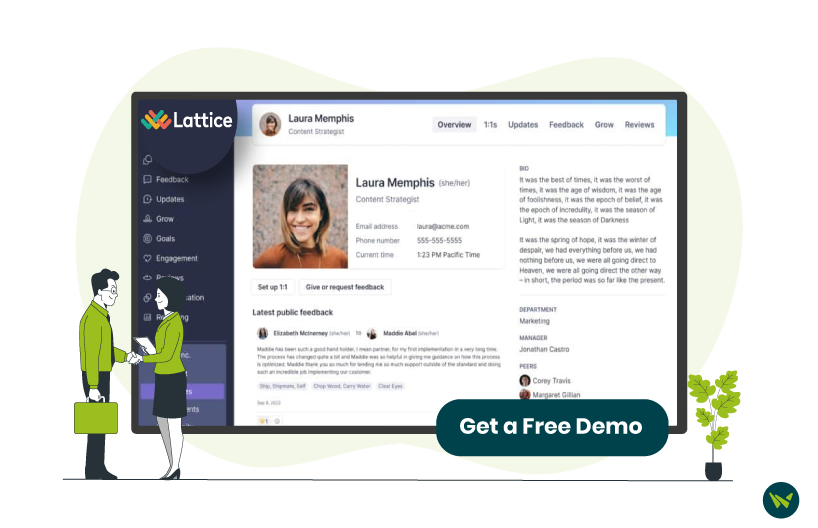
Lattice HR is best known as a performance management platform, but its engagement tools are tightly integrated with the rest of its system—which is where it stands out.
You get the usual components like performance reviews, 360° feedback, and goal tracking (OKRs), but it’s the continuous feedback threads and built-in pulse surveys that tie everything together. These surveys are customizable and come with a library of benchmark questions, so teams can track morale over time and compare results against industry averages.
The real strength is in how everything connects. Survey results feed directly into people analytics dashboards, alongside performance and goal progress. That makes it easier for HR teams to spot patterns—like how recognition or feedback might be impacting actual outcomes.
5,000+ teams worldwide use Lattice’s platform to develop and engage employees. Notable customers include Gusto, Shippo, Robinhood, and Discord.
Best For: Mid-size to large companies that want to align engagement with performance.
Pros:
- Employees can submit updates using built-in forms to keep managers informed
- Anonymous surveys and feedback tools help monitor engagement and satisfaction
- Admins can view participation rates and trends to assess organizational health
Cons:
- The absence of a built-in communication tool limits immediate collaboration within the platform
- Employee feedback is routed through email instead of being stored within the system
Pricing
Lattice’s core Talent Management plan starts at $11/user/month (annual billing).
Disclaimer: The pricing is subject to change.

15Five takes a different approach by centering everything around regular check-ins and coaching. The name comes from its core habit: employees spend 15 minutes each week filling out a short update, and managers spend 5 minutes reading it. It’s a simple format, but useful for spotting wins, blockers, or morale dips early.
Managers get structured support too, with built-in 1-on-1 meeting agendas and coaching prompts designed to keep conversations focused and consistent. There’s also goal tracking (OKRs), peer recognition through ‘High Fives,’ and an engagement survey module with deeper analytics than most tools in this space. One thing that helps the surveys stand out is how they’re backed by data—15Five compares responses against insights from over 600,000 surveys to highlight patterns and flag areas for improvement.
For teams that want to go further, 15Five offers add-ons like manager training programs—making it feel more like a full development platform, not just a feedback tool.
Over 3,000 companies use 15Five to engage and develop their employees. Well-known brands like Udemy, 1Password, and HubSpot are part of that number.
Best For: Companies (50–500 employees) that want to build a consistent feedback culture and track goals weekly.
Pros:
- Its weekly check-ins help employees stay accountable for their tasks
- Most users find the UI straightforward and well-designed
- Pulse checks and feedback tools help track team sentiment over time
Cons:
- Visibility into goal completion at the org chart level is limited
- There are no alerts for stalled OKRs or overdue tasks
Pricing
15Five starting price is $4/user/month (billed annually) for the Engage plan. There’s a 14-day free trial to test it out.
Disclaimer: The pricing is subject to change.

Employee feedback and analytics are where Culture Amp leads the market. It offers a library of science-backed 40+ survey templates designed by data scientists and organizational psychologists. What makes them more useful is the built-in benchmarking, so you can compare results against similar companies in your industry.
Once responses come in, Culture Amp turns the data into intuitive dashboards and heatmaps. These help HR and managers spot where things are working—and where they’re falling short—across teams or departments.
There’s also a practical layer to it. The platform includes action planning tools that suggest steps managers can take based on what the data shows. It helps close the loop instead of just collecting feedback and moving on.
Beyond surveys, Culture Amp also includes modules for performance reviews and 360° feedback, so everything from engagement to development can live in one system.
Over 6,000 companies worldwide rely on Culture Amp. High-profile customers include Salesforce, PwC, SoulCycle, and BigCommerce, among others.
Best For: Mid-size and enterprise companies in tech, retail, or finance looking for deep engagement insights.
Pros:
- Reports are easy to interpret and support deeper insight into engagement trends
- Survey results can be contextualized using external benchmarks
- Its built-in live chat connects users directly with support specialists
Cons:
- The platform doesn’t allow users to track their personal feedback history
- Lacks a notebook or journal feature for tracking growth
Pricing
Culture Amp pricing is estimated between $9 to $14/employee/month.
Disclaimer: The pricing has been sourced from third-party websites and is subject to change.
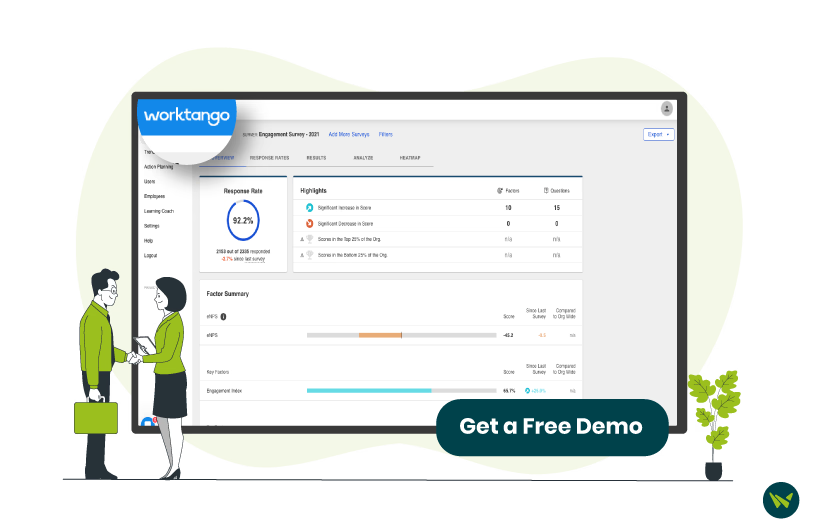
WorkTango is built around three things: employee feedback, recognition, and goal alignment—and it does a solid job of tying them together in one system.
On the engagement side, you can run unlimited surveys—whether it’s a quick pulse, eNPS, or something focused on DEI. The dashboards are auto-generated and come with AI-driven suggestions, which help managers figure out what to do next without needing to be data experts.
But what really sets WorkTango apart is that it goes beyond measurement. The platform includes a peer recognition feed with points, a flexible rewards catalog, and 50+ incentive templates you can use or customize. Employees can redeem points for products, experiences, and swag from brands like Apple or Amazon—across global, local, and digital options.
WorkTango reports supporting over 750,000 employees, including teams at major organizations like Boston Beer Company and Apple Federal Credit Union.
Best For: Companies wanting a robust combo of recognition & feedback in one platform (ideal for former Kazoo/WorkTango users).
Pros:
- Its interface and interaction model make recognition more engaging and consistent
- Users benefit from strong onboarding help and ongoing assistance
- The software functions smoothly on mobile, allowing recognition on the go
Cons:
- There are no alerts to remind users to distribute or redeem unused points before expiration
- Some users note difficulties in tagging employees or filtering recognition at a team or department level
Pricing
WorkTango pricing roughly starts at $8/user/month for the core platform, based on industry benchmarks.
Disclaimer: The pricing has been sourced from third-party websites and is subject to change.
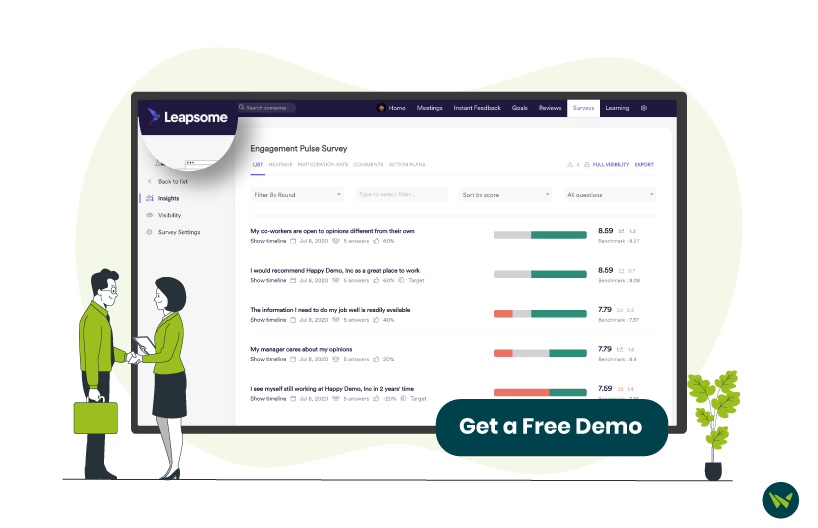
Leapsome brings together engagement surveys, performance reviews, goals, and learning into one connected platform. It’s designed to help companies not just gather feedback, but act on it in a structured way.
Where Leapsome adds value is in its approach to engagement, it includes customizable pulse surveys, eNPS tracking, and lifecycle surveys for onboarding and exit. Results can be explored further through anonymous conversations, which helps uncover what’s really driving responses. AI-generated insights and action plans are built in, so it’s easier for managers to know what to do next.
The platform also covers performance management. It supports 360°, project-based, and leadership reviews, and these are relatively quick to set up and complete. There’s a built-in tool for 1:1s and team meetings as well, with shared agendas and talking points that keep conversations focused.
Over 1,500 companies, including some of the most innovative names like Spotify, monday.com, and Unity, are using Leapsome.
Best For: Mid-sized, forward-thinking companies, especially in tech, seeking a holistic talent management system.
Pros:
- Includes built-in learning modules that support employee training
- The platform is generally intuitive once users become familiar with it
- Internal employee surveys are widely used and impactful
Cons:
- No option to track bonus or increment details within the platform
- Does not include built-in rewards and recognition features
Pricing
Leapsome offers modular pricing starting around $3/user/month (billed annually) for a single module (e.g. just engagement surveys).
Disclaimer: The pricing has been sourced from third-party websites and is subject to change.

While BambooHR is mostly recognized for its core HR capabilities, it also folds in a few engagement features that make it more than just an HRIS. What’s useful for managers is the ability to track eNPS scores over time or across departments. It’s a simple way to spot trends early, especially when trying to understand dips in morale or engagement.
Something that adds value here is the Employee Community—a newsfeed-style hub that centralizes announcements, celebrations, and company-wide updates. It gives teams a casual but organized space for internal communication and day-to-day recognition.
For more structured insights, BambooHR also includes a Wellbeing Heatmap that surfaces areas of stress or low engagement, plus a set of research-backed survey questions that take the guesswork out of what to ask.
BambooHR reports that over 30,000+ companies worldwide rely on it, including SoundCloud, Jacksonville Jaguars, and Postmates.
Best For: Companies with 50–500 employees needing an intuitive, cloud-based HR system with built-in engagement tracking.
Pros:
- Live chat is handled by real support agents, not bots
- Built-in eNPS surveys promote regular employee input
- Company announcements and updates are visible to employees in one central location
Cons:
- Mobile org chart and data access could be improved for better employee usability
- Announcements don’t integrate with external communication tools like Slack
Pricing
BambooHR pricing ranges at $6/employee/month, depending on the selected features and plan.
Disclaimer: The pricing has been sourced from third-party websites and is subject to change.
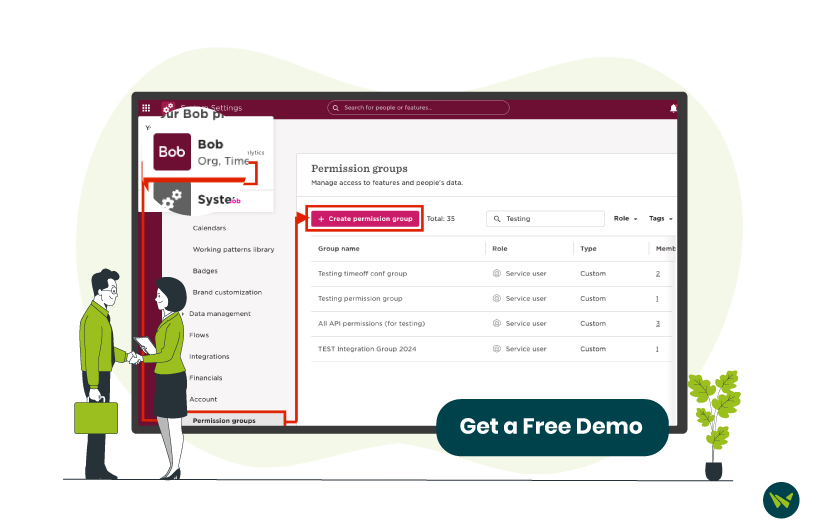
HiBob (or just ‘Bob’) is an all-in-one HRIS designed to modernize how companies manage their people and culture. It blends essential HR functions with thoughtful engagement tools, making it more than just a back-office platform.
Another most important feature is its built-in performance support, which covers core processes without much setup. There’s support for 360° feedback and goal-setting, plus dashboards that highlight DEI data and turnover risks—useful if you’re trying to spot issues early.
Bob also adds a social layer to HR. There’s a company newsfeed, shoutouts via kudos, and automated birthday and anniversary alerts—all of which help reinforce culture, especially for remote or distributed teams. Beyond engagement, it covers the core HR essentials: time-off tracking, org charts, onboarding workflows, and even integrates with payroll systems.
Many organizations use this system, including The Brand Power Company, Ualá, and Montu.
Best For: Mid-size companies (100–1000 employees)—especially fast-scaling or multi-country teams.
Pros:
- Performance reviews and one-on-one tools help drive feedback culture
- Weekly pulse surveys provide real-time feedback and engagement insights
- Real-time analytics allow managers to take timely action on engagement data
Cons:
- Lacks legally binding signature tools, limiting trust in employee-related documentation
- No option for employees to request their own 1:1s meetings
Pricing
HiBob pricing starts in the range of $16 to $25/employee/month, depending on the features and company size.
Disclaimer: The pricing has been sourced from third-party websites and is subject to change.

Achievers puts recognition at the heart of engagement—especially for larger companies with distributed teams. What makes it more meaningful is how recognitions are tied to company values and appear in a live social feed. Employees can give each other shoutouts and earn points, which can then be redeemed for rewards.
The rewards system is flexible, too. Employees can choose from 25,000+ gift cards, branded items, or experiences—across global and local options.
Another important feature is ‘Achievers Listen,’ a pulse survey tool that collects anonymous employee feedback. The system uses AI to summarize sentiment and highlight common themes without manual digging. What helps managers take action is that Achievers also suggests next steps based on what’s surfaced—making feedback more actionable instead of just informational.
This system is trusted by a wide range of organizations, including well-known names like Workday, Samsung, and Dyson.
Best For: Large, global enterprises seeking a recognition-driven engagement platform with multilingual and rewards support.
Pros:
- Enables managers to publicly recognize and reward employee efforts
- Recognition activity is visible company-wide, encouraging transparency and morale
- Offers a wide range of rewards, including gift cards, merchandise, and curated experiences
Cons:
- Lacks deep integration with company intranet or internal tools
- Inconsistent use by managers can lead to perceptions of favoritism
Pricing
Estimates suggest the median Achievers contract costs approximately $126,362/year, based on data from nine purchases.
Disclaimer: The pricing has been sourced from third-party websites and is subject to change.
Not every company needs an all-in-one platform, and not every tool delivers what it promises. What really matters is how you plan to drive engagement—whether that’s through peer recognition, frequent feedback, or deeper analytics around sentiment and culture.
If you’re just getting started and want something simple to boost recognition, Bonusly or 15Five might be enough. If your focus is deeper feedback and analytics, Culture Amp or Lattice offer more structure and visibility into what’s working (and what’s not).
On the other hand, if you’re already using an HRIS like BambooHR or HiBob, their built-in engagement features might be more convenient than adding yet another tool.
What matters most is choosing a system that fits the way your team works—one that people will use consistently. Use this list as a starting point, and if you’re still unsure, head to our resource center for more detailed comparisons and guidance.
